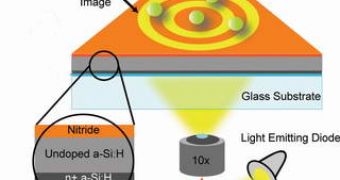It seems that nanoscale objects can be controlled with the use of light.
Based on the quantum mechanical effects of light, optoelectronics is the study and application of electronic devices that interact with light, and thus is usually considered a sub-field of photonics. In this context, light often includes invisible forms of radiation such as gamma rays, X-rays, ultraviolet and infrared. Optoelectronic devices are electrical-to-optical or optical-to-electrical transducers, or instruments that use such devices in their operation.
Researchers at the University of California-Berkeley have invented "optoelectronic tweezers," to control nanoscale objects, much like people use normal tweezers to grab tiny objects.
The researchers used a photosensitive surface made of amorphous silicon, a common material used in solar cells and flat-panel displays. Microscopic polystyrene particles suspended in a liquid were sandwiched between a piece of glass and the photoconductive material. Wherever light would hit the photosensitive material, it would behave like a conducting electrode, while areas not exposed to light would behave like a non-conducting insulator. Once a light source is removed, the photosensitive material returns to normal.
Depending upon the properties of the particles or cells being studied, they will either be attracted to or repelled by the electric field generated by the optoelectronic tweezer. Either way, the researchers can use that behavior to scoot particles where they want them to go.
Unlike optical tweezers, that use light to manipulate minute objects as small as a single atom with radiation pressure from a focused laser beam, in the new device, researchers reflect light from a digitally controlled array of mirrors, sending the light through a magnifying lens, and then into a sandwich of semiconductor planes, creating (at the interface between two of the planes) as many as 15,000 traps that can be addressed separately. In each of the traps, objects such as biological cells can be studied.
The novelty consists in the fact that optoelectronic tweezers don't use optical energy to create powerful mechanical forces, but rather to create high electric forces in carefully prescribed places.
The superiority of the optoelectronic ones is that they use much less power than optical tweezers and don't need to be as carefully focused.
Recently, they successfully used their locally controlled electric fields to manipulate the positions of tiny nanorods (100 nanometers in diameter and 1-50 microns long). The rods are suspended in a thin layer of water by sound waves and then transferred to the tweezer apparatus.
Future applications will involve using the device to place rods in order to build 3-D circuitry or for positioning oblong-shaped cells or cell protrusions with micron-level precision.

 14 DAY TRIAL //
14 DAY TRIAL //